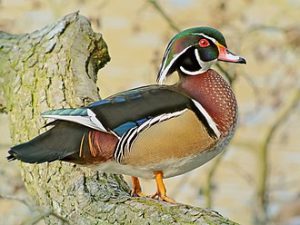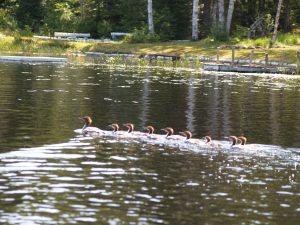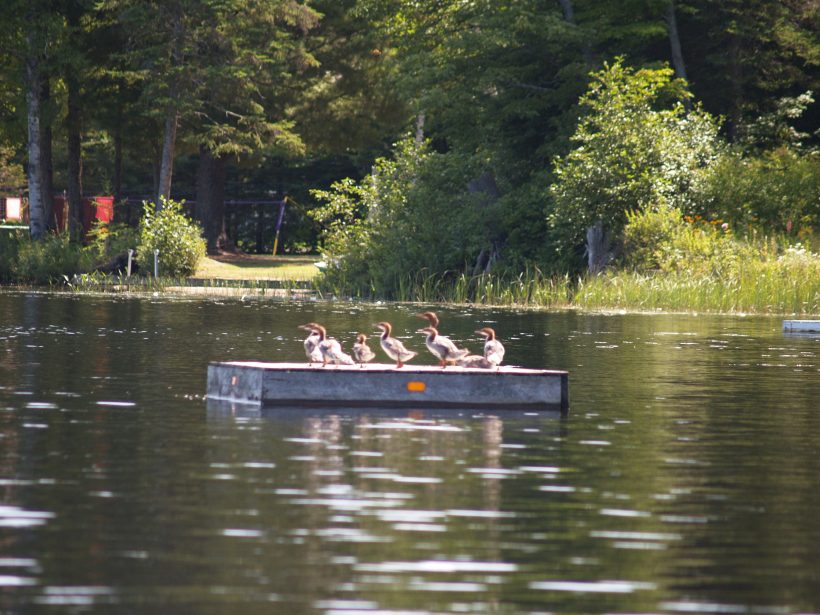MOSTLY MERGANSERS by Ralph Bice
From Wednesday, September 20, 1978
Recently there has been an article in Ontario Out of Doors complaining about the lack of interest the Ministry of Natural Resources is showing about duck hunting along the shores of the Great Lakes where some species are getting very plentiful and hunting is not permitted. Then there is an article in The Raven, an interesting pamphlet issued a dozen times during the summer from Algonquin Park. It dealt with only hooded or crested merganser and that most beautiful of all ducks, the wood duck. The writer tells of seeing broods of wood ducks and how they resemble the hooded merganser. And both nest in trees. Interesting, as l have never known of wood ducks nesting this far north or at least in the Algonquin Park area. In fact, I have travelled just about every river and lake in the Park and only once have l seen a pair of these small ducks.

There are, or were, three types of merganser, the American merganser being the most common. This one is a bit larger than the hooded but they both nest in holes in trees. One hooded type used to nest right beside the old fire ranger’s cottage at Eagle Lake Landing on Rain Lake in a tall pine stub. One spring early workers using the camp cut down the tree for wood. The hole where the nest was located was at least 30 feet from the ground and often we watched to see how the baby ducks got to the ground but never were lucky.
The same nest is used for years unless someone cuts it down. There was an old stub pine near the shelter house on Butt, or as it was then called, Eagle Lake. An early fisherman found it and took two of the three eggs. These he cooked and ate. My Dad was the ranger there and this man, who was very interested in ducks, asked Dad to watch the nest and take the eggs, always leaving two so the mother bird would keep on producing eggs. This one bird, an American merganser, laid a total of 33 eggs and then left.
For many summers we had a fishing camp on Butt Lake and one day when wood gathering l scared one of those ducks and she flew from her nest in a rather large birch tree, still living, but there was a hole about 20 feet up where there was a crotch large enough for a duck to get in and out.
Many years ago two of us watched a nest on Cache Lake at headquarters in Algonquin Park. This nest was in a stub, open at the top, and the eggs were at least three feet down from the top. There was a leaning tree we could walk on and it was easy to see right down from the open top. If l remember there were a few more than a dozen eggs in this nest. One day they hatched and then there was a flock of baby ducks.
Merganser males do not stick around long. After the mating season they disappear. I have read that the female also takes off once the brood can fend for themselves. The drakes of both types are very beautiful. The American type males are pure white except for the head and neck. In the fall, before they leave, it can be noticed that the males are beginning to show a white body. Males of the hooded type are at times taken for wood ducks.
One early summer, l believe it was 1936, a party of us camped on Little Trout Lake, the first lake east of Butt Lake. Three families of American merganser ducks hatched within days of each other. In all there were well over 30 baby ducks. Some days one mother would have nearly all the little ones. Some days they would be almost evenly divided. But as long as there was a mother around it did not matter which one.

This type of duck is not good eating. The young ones in the early fall are not too bad but an adult is not. I can recall trying to eat a male years back when we trapped in Algoma. It was in the spring but supplies were getting low. The odour of the duck being cooked was more than we should stand and even after long boiling when it did get soft the taste was terrible. Too, we could never again use that pail to cook anything else.
This type of duck were called ‘sawbills’ when l was small. Their beak is long, and it has teeth along the edges. Grebes also have similar beaks. All the fish-eating ducks are greatly reduced in numbers the last few years. Perhaps because of what they are eating during the winter or another cause. One thing, they are not destroyed by hunters as they are seldom eaten. But it would be sage to say that there are now less than 20 percent of the mergansers there were 15 years ago.
During the spring and fall flights many ducks are seen. One spring on Tims Lake, following a heavy storm in the north, we saw several pairs of ducks that are not native. The only broad bill, the black duck that nests here, are getting fewer. Years back there were many black duck nests, many on open area on points. Once on a little island on David Lake there was a black duck, a gull, and a loon’s nest not many years apart. Funny, but we never saw flocks of black ducks until they were almost grown. They must keep well hidden when small.
Merganser ducks eat many small fish. Years ago I knew one such duck to have seven small bass in its crop and it was one of a flock. I have not witnessed it but have at different times been told of loons catching small mergansers. But years ago there were so many flocks. Mostly the American and they must have taken many fish. They were nice to watch in the summer months and let’s hope they do make a come-back.

